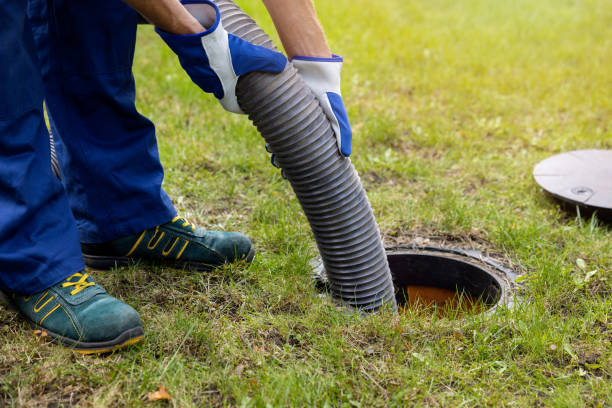How Often Is Septic Tank Pumping in Huntsville AL Advised Before Symptoms of Backup Become Obvious?
Underground systems work quietly until they don’t, which leaves many property owners unaware of how fast a tank fills. Septic maintenance works best when scheduled by math, household behavior, and system stress—not warning signs like odors or slow drains. Knowing the right timing for septic tank pumping Huntsville AL service prevents avoidable emergencies and protects the drainfield long before failure begins.
Standard Pumping Intervals Based on Household Size and Water Usage
Tank size alone does not determine pumping frequency—daily water volume does. A home with two people producing moderate wastewater often operates safely with septic tank pumping every 4 to 5 years. A household of five or more routinely using showers, washing machines, and dishwashers fills the same tank nearly twice as fast, moving the schedule closer to 2 to 3 years.
Water usage patterns adjust the timeline even further. Filling a garden tub, running irrigation off household supply, or hosting long-stay guests adds measurable load to the system. A septic tank may reach sludge capacity months earlier than expected when lifestyle increases demand.
Waste Accumulation Rate Differences Between Older and Newer Systems
Newer septic tanks generally include updated inlet baffles, improved wastewater flow design, and better material resistance. These features help solids settle more effectively, which slows the rate of sludge migration toward the drainfield. When maintained properly, newer setups can stretch pumping cycles slightly longer without raising risk.
Aging systems deal with partial obstructions, bio-layer buildup, and interior wear that affects separation efficiency. Solids shift into the tank’s mid-layer faster, leaving less usable volume and requiring faster turnaround for septic tank cleaning. The system does not fail faster because it is old—it fails faster when age reduces its ability to sort waste.
How Drainfield Stress Signals Shorter Pumping Cycles
The drainfield often shows strain before the tank alarms do. Pooled spots, grass growing brighter in strips, or soil staying damp after rain can signal wastewater pushing outward instead of filtering downward. These patterns mean the tank is running too full, too often.
A stressed drainfield translates to a shortened pumping schedule whether the tank “looks full” or not. Even one overflow event can push solids into distribution lines where they don’t belong. Septic tanks work best when emptied on a preventive timetable rather than after soil absorption slows.
Sludge Layer Growth Timelines Most Homeowners Miscalculate
Many assume a tank fills bottom to top evenly, but sludge behaves more like a rising floor than a rising liquid. As engineered bacteria break down organics, heavy solids accumulate and slowly thicken into a compact layer. This layer can reduce tank capacity by 30% before any surface sign appears.
Misjudgment happens because wastewater still drains normally until a tipping point is reached. A tank can appear functional one month and overwhelmed the next when the sludge layer crosses a threshold too close to the outlet pipe. Septic tank pumping is most effective when scheduled before that threshold forms.
Seasonal Water Usage Changes That Impact Tank Fill Speed
Summer use increases tank inflow faster than any other season. More showers, heavier laundry cycles, lawn watering, and extra overnight guests boost wastewater numbers significantly. Vacation seasons alone can raise household water output by 20–40% for short stretches.
Winter shifts usage patterns but not always in a favorable way. Fewer outdoor activities lead to longer indoor water use, including extended showers and more wash loads. Rainier months also saturate soil, slowing drainfield absorption and backing pressure toward the tank, which effectively makes the system feel full sooner.
The Role of Disposals, Laundry Habits and Long Showers on Pump Timing
Food disposals place massive strain on septic systems because they add solids that bacteria struggle to break down before settling. Even small daily use can double organic waste volume entering the tank. Frequent loads of laundry, especially back-to-back cycles, push gallons rapidly without pause for solids to separate.
Long showers contribute steady inflow, but it’s the combination of habits that shortens service intervals the most. Systems do not respond well to spikes in volume or continuous inflow with no rest period. Septic tank cleaning schedules must account for behavior, not just headcount.
Why Delaying Service Shortens System Lifespan Instead of Saving Money
Skipping recommended pump intervals does not stretch a budget—it shifts expenses into repairs. When solids overflow into outlet pipes, they clog lines, foul distribution boxes, and can permanently scar drainfield trenches. Replacement of any one of these components costs far more than routine maintenance.
A healthy septic tank protects the system beyond the tank itself. Pumping preserves the biological balance, prevents back-pressure buildup, and keeps costly excavation or reconstruction off the forecast. Predictable service intervals always outperform reactive problem repairs.
The Maintenance Schedule Gap Between Rural and Suburban System Loads
Rural systems often handle fewer daily water spikes due to larger lots, fewer connected appliances, and reduced municipal water pressure. However, they may process additional mud, outdoor runoff, or well fluctuations that suburban systems rarely see. Suburban septic tanks typically fill faster because of denser occupancy and higher indoor water dependence.
The environment surrounding the system also shifts the timeline. Clay-rich soil, common in parts of Huntsville, slows drainage and requires closer monitoring. Tanks in these zones benefit from slightly shorter pumping cycles to avoid hydraulic backup, a risk amplified during wet seasons.
Septic timing works best with proactive scheduling rather than symptom tracking. System longevity, drainfield health, and prevention of backups depend heavily on predicting fill speed before reactions begin. For property owners needing consistent monitoring and septic tank pumping Huntsville AL support, Cora Landscape offers long-term maintenance solutions to keep systems stable and protected.




